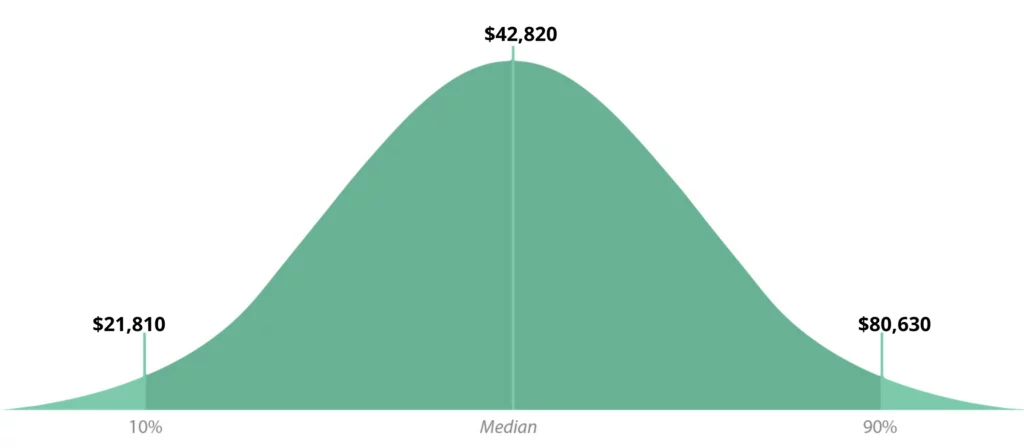
1. Overview: Job Responsibilities, Salary, and Common Requirements
2. A Comprehensive Guide to Becoming a Massage Therapist
3. What Does a Massage Therapist Do?
4. Signs You Should Consider Becoming a Massage Therapist
5. How Do You Become a Massage Therapist?
6. What Kinds of Jobs Can A Massage Therapist Do?
7. What are the Knowledge and Skills Needed to be a Massage Therapist?
8. Popular Schools and Colleges in the U.S. for Aspiring Massage Therapists
9. How to Get a Job as a Massage Therapist
9. Learn About Geographic and Location Pay Differentials
10. Make Your Resume Stand Out
Massage therapists made a median salary of $42,820 in 2019. The best-paid 10 percent made $80,630 that year, while the lowest paid 10 percent made $21,810.

Acupuncturist
Athletic Trainer
Exercise Physiologist
Chiropractor
Fitness Trainer
Health Specialities Teacher
Naturopathic Physician
Occupational Therapist
Anatomy
Physiology
Kinesiology
Types of Massage
Communication Skills
Customer Service Skills
Physical Strength and Stamina
Cultural Understanding
Entrepreneurship
Massage therapists improve the wellness of their clients by the power of their touch. By performing therapeutic massages, they are able to relieve pain, alleviate stress, heal injuries, improve blood circulation, promote relaxation, and more. Massage therapists are in both healthcare and hospitality industries, working in different kinds of environments such as hospitals, private offices, spas, fitness centers, and even in their clients’ homes. They also collaborate with other healthcare professionals such as chiropractors, psychologists, physiotherapists, and physicians.
Massage therapists were reported to have a median salary of $42,820 per year according to the Bureau of Labor Statistics (BLS) last 2019. As there is continued growth in demand for massage services, the employment rate of massage therapists is expected to grow 21% from 2019 to 2029–considered much faster than the average for all occupations.
With the rising number of people looking at massage therapy for treatment, there is no doubt that massage therapists are becoming more in demand today.
Massage therapists manipulate the muscles and soft tissues on their client’s body to treat medical injuries or promote general wellness. They work extensively with their fingers, hands, forearms, elbows, and sometimes feet. While there is a wide array of career paths and workplaces massage therapists can choose, they generally do the following:
Can you envision yourself becoming a successful massage therapist? Aside from having in-depth knowledge of the human body as well as physical strength and dexterity, below are some ideal qualities you should possess.
Each client differs in emotional and physical needs. A great massage therapist should be able to listen closely to his clients in order to determine the best type of treatment. One technique might not work for the other so you must be ready to modify it according to the client’s comfort level. You can ask what exercise or massage brings them pain, as well as what brings them satisfaction. By taking the time to listen to their feedback, you are able to address their concerns and provide appropriate service.
Not only should you be able to listen carefully, but you must also know how to explain thoroughly your treatment. It’s vital to discuss with your client what you will be doing during the session, as well as the reasons why you will be doing it. Moreover, a massage therapist should always be prepared to answer any possible questions their client might raise.
The nature of massage therapy requires the massage therapist to be caring and mindful of the client’s experience. You have to create a nurturing environment and provide a service that will heal your client from their stress or pain. When you accomplish this by effectively communicating and delivering a positive experience through a massage, you are creating a rapport and building trust. Not only is this essential for success, but you are also contributing to the wellness of your client.
Massages demand great physical strength and stamina. An efficient massage therapist is one who can stay on his feet and perform massages several times a day, sometimes even consecutively. Each session consists of a variety of movement and pressure so you must be physically able to execute techniques properly without getting tired.
Establishing and maintaining your reputation as a massage therapist is crucial for success in the industry. There is no room for your personal problems and stress in life because your priority is your client’s satisfaction. You should be able to set aside any distractions that would potentially affect the quality of your service. They go to a massage therapist with a desire to relax, so you must present yourself in a way that is going to make them feel relaxed, not stressed out and uncomfortable.
Moreover, you should ensure that you stay on top of everything. Be early to appointments and avoid missing calls because small errors like these are deciding factors for your clients. Always remember that the level of your professionalism is proportionate to the quality of your customer service.
A competent massage therapist is always hungry for knowledge and improvement. You can expand your skills and stamina through continuous learning, as well as by listening to clients’ feedback. It’s always possible to discover something new every session so you must be open to learning. Aside from this, you can also specialize in a few types of massage instead of limiting yourself to just one. Those who are experienced in different types and techniques of massage are more likely to be an impressive candidate.

Practice laws and education requirements vary by state and jurisdiction. According to the American Massage Therapy Association (AMTA), there are currently 47 states (including the District of Columbia) that regulate the field of massage therapy. These states include:
While it’s important to research on your locality’s regulations, here are the typical requirements to become a massage therapist:
An aspiring massage therapist should enroll in a massage therapy education program. Most programs usually require only a high school diploma or equivalent for admission. You must render at least 500 hours of study in order to be qualified for a certification exam, however, some programs require 1,000 or more hours.
It’s important to also be on the lookout for programs/schools accredited by the following organizations:
To determine which program is right for you, check out your state’s licensing requirements.
The requirements in acquiring your license as a massage therapist vary for the majority of states. Most states impose these regulations to ensure the safety of the patients.
Only four states do not have a statewide regulation—Kansas, Minnesota, Vermont, and Wyoming. But the massage therapists who wish to practice here may need to follow any local licensing laws and regulations.
The duration of processing your license application varies per every state. You’ll need to check on your state regulatory board to get an idea of how long.
Usually, the state massage requirements consist of 500 hours to 1000 hours of classroom or supervised training by an accredited school. The states sometimes provide a list of accredited schools where you can get these massage therapy training.
After the training, you will need to pass an examination for your license. This is to ensure that all applicants are on par with their standards. The current industry-standard licensing exam is the MBLEx, which is also accepted by all states. You may check on this for more additional instructions for the said exams: Federation of State Massage Therapy Boards (FSMTB).
Additional licensing requirements:
In addition to passing the exam, here are some common requirements imposed by some state massage licensing boards.
Once you have your license, you can further your career by getting massage therapy certifications. You can get this through the National Certification Board Therapeutic Massage and Bodywork. This credential is said to be the industry’s top achievement for every massage therapist.
In earning this credential, here are the requirements you need to meet:
Some states also require massage therapists to pass a background check and have liability insurance. There may even be a need to be certified in cardiopulmonary resuscitation (CPR). Again, those who desire to become a massage therapist should do thorough research on the regulations and legal requirements for the state and locality in which they intend to practice.
As a certified/licensed massage therapist, you have the option to choose the setting you wish to practice in. The environment you choose will determine your specialization as a massage therapist. Here are some potential workplaces, both in the healthcare and hospitality industries, to consider:
Depending on the setting, you can have the benefit of flexible hours and the chance to treat both new and long-term clients. You can also work independently as a self-employed massage therapist.
Take note: Once successful in obtaining your license and certification, see to it that you comply with renewal dates and other requirements such as completion of continuing education classes in order to retain the practice.
In any industry, it is vital to network with other professionals. Immersing in the community you are a part of will build connections that will help you succeed in your massage therapist career, especially if you decide to become self-employed. Listed below are some of the most well-known groups for massage therapists:
Being a massage therapist presents a variety of opportunities in your career. You are not stuck with one option to practice your craft. There are several specialties you can take in your job as a massage therapist.
This specialty consists of the most common types of massage therapy techniques. Aesthetic massage is mainly used for toning tissues, alleviating tension, and promoting relaxation. Some of it includes the Swedish massage, hot stone, aromatherapy, and chair massage.
Massage therapists can practice in the medical field as medical professionals rely on particular massage types to aid patients’ physical conditions. Some of the massage modalities commonly used are deep tissue, trigger point, neuromuscular, myofascial release therapy, etc.
If you want to lean more on the medical field, it is advised to pick a science-based continuing education program.
There are a lot more specialties to look into when planning to become a massage therapist. Some other massage therapists are needed in the following fields:
Here are the places where you could practice massage therapy:

To become a massage therapist, you must have knowledge of the following:
You must know and understand the parts of the body, the different structures, and its relationship with one another. With this knowledge, you can identify and heal the muscles that your clients have raised concerns with. It’s not enough to just point out a specific area and start massaging it–you must be aware of how muscles work together and affect one another to effectively treat them.
In the simplest terms, physiology is the study of the body’s systems–the skeletal, muscular, nervous, respiratory, and other systems. This goes hand in hand with the study of anatomy to ensure the utmost safety when developing a treatment plan for the client, as well as when giving the massage. Massage therapists need to be informed on any type of sickness or disease the client may have that might have direct or indirect effects on other parts of the body.
This study focuses on movement–understanding how and why body parts move and interact. Aside from the relaxing benefits a massage can bring, it can also be aimed to treat conditions such as recurring injuries due to motion, poor posture, or limited movement. Being able to recognize how a certain body part is supposed to move along with other body parts that are involved will help determine the best treatment plan to aid healing and restore proper movement.
Also known as modalities, the most popular types of massage therapy and its benefits are:
– Known as the standard and most common type of massage, this relieves tension in the muscles and promotes full-body circulation and relaxation. A sequence of strokes called effleurage (long, smooth, and gliding); petrissage (kneading, squeezing, lifting, and rolling); friction (deep movements in circular motion), tapotement (short, rapid striking and tapping); and vibration (rocking and shaking) are involved during the session. A Swedish massage can also aid in recovery from injury.
This type of therapeutic massage is focused on “untying” knots in your muscles where tightness or pain is felt. The execution involves more intense pressure, stroking, and friction of the problem areas compared to a Swedish massage. A deep tissue massage can alleviate chronic pain, help treat injuries, and improve mobility.
– Shiatsu means “finger pressure” in Japanese. This type of massage uses techniques that utilize the massage therapist’s fingers, hands, elbows, and sometimes feet. By stimulating acupressure points for two to eight seconds, a Shiatsu massage boosts circulation and increases the energy and balance of the body. This is a great choice for relaxation and de-stressing.
– Similar to Shiatsu, Thai massage also improves the flow of energy throughout the body. This involves movement and stretching – like yoga, but with the assistance of the massage therapist. The benefits of this type of massage include relaxation, improved flexibility, and increased range of motion.
– This massage is designed specifically for athletes to enhance athletic performance. While the targeted muscle groups and tissues will differ depending on what sport the athlete plays, this massage aims to improve flexibility and range of motion to prevent and treat injuries. Non-athletes can also benefit from this.
– This light pressure massage promotes the circulation of lymph fluids in the body. Long, gentle strokes are performed along the skin, which helps remove toxins from the tissues.
– This foot massage involves the stimulation of certain areas of the feet believed to correlate with other parts of the body and its systems. Applying pressure on these points reduces stress and promotes overall well-being.
– This massage consists of placing warm basalt stones on the back to loosen tight muscles and improve blood flow. With the heat helping to ease knots, the therapist can easily work on troubled areas of the back.
– As the name implies, this type of massage is aimed for pregnant women. Pregnancy massage, also known as prenatal massage, promotes relaxation and reduces pain such as lower back or joint pain. This is a safe way to alleviate stress and anxiety for expecting mothers.
You can choose to specialize in one or few, however, it is not a requirement to learn all these.
If you intend to start a private practice, it is a must to have knowledge on how to run a business. You need to obtain a business permit and comply with other requirements in order to provide services as a self-employed massage therapist. A well-organized scheduling and management system can streamline your business operations, greatly enhancing your efficiency and client satisfaction.
Aside from the knowledge needed to provide a safe and effective massage, you must also have a specific set of soft skills to create an experience that is valuable to your client. Listed below are additional qualities a massage therapist should possess in addition to the ones mentioned in the ‘Signs You Should Consider Becoming a Massage Therapist’ section.
In this industry, you will meet men and women of different cultures and backgrounds. Each of them will also fall under different age brackets and professions. As a massage therapist, you are expected to help all of them feel welcome and at ease right when you first interact. Beyond just putting up a friendly front, you must be able to ‘read’ clients so you can adjust and cater to them accordingly.
Maintaining a high standard of professionalism calls for outstanding organization. To avoid the risk of being late to an appointment or missing it entirely, you must have your schedule in order especially if you are a self-employed massage therapist. Apart from your massage sessions, you will also have a variety of business-related tasks such as finance, customer service, and more so it’s imperative to be highly organized in this career.
Prior to performing a massage, you will have an initial consultation with your client. During this consultation, your client will talk about his concerns and his current condition. You must know how to evaluate and decide which type of massage therapy is best for him or if it is even beneficial at all. You are more equipped to determine what type of procedure the client will need and if necessary, you should be able to refer him to the correct medical professional.
Although this is a given, good hygiene is essential in massage therapy. It should start with yourself–make sure your hands are clean, nails are trimmed, and hair is neatly pulled back. You should also be aware of your body odor; avoid any strong perfumes or scented lotions that could possibly bother your clients.
Aside from upholding personal hygiene, you must also see to it that your space is clean and well-maintained. Your sheets, blankets, and pillows should be regularly and properly washed with no traces of stains, as well as scent. Keep in mind that your clients will notice these things. No matter how good your massage service is, slipping up on your area’s cleanliness and comfortability will drive them away.
According to Niche, here are the top colleges in the U.S. for 2021 that provide massage therapy and bodywork degrees:
You can also check out AMTA’s Find a Massage School locator service to find AMTA member schools in your desired location.

Looking for a job is easier when you know what you want–what’s more challenging is actually landing the job. Here are some ways you can find a job as a massage therapist:
It’s fairly easy to search for a job opening today, given that there are various job portals accessible on the web with just a click. Searching for a massage therapist job online is fast and convenient when you know where to look–here are a few sites you can check out:
You can also go to a search engine and type in ‘massage therapist job openings’ or even add your specialty such as ‘reflexology massage therapist job opening’ and other variations to narrow down results according to your expertise. Make sure to include the location you want to practice in.
Whether you want to work at a hospital, rehabilitation center, sports center, hotel or spa, it’s important you stay updated. By now, you probably have your options on which companies you wish to become a part of. Job openings won’t notify you themselves so if the companies you desire have a website, scan it every now and then. Better yet, go to their office, try to find the bulletin board of announcements or just straight up ask. Maybe the company sends out notification emails, too. Whatever their way of getting the word out, you should see to it that you are in the loop.
If you’re family or friends with people in the healthcare or hospitality industry, they’ll most likely be updated on current job openings in their company. It wouldn’t hurt to ask them for referrals or even just information regarding the job. With the high demand for massage services today, there is a good chance your local hotel or spa is looking for an additional massage therapist.
One of the biggest benefits you can get from joining professional associations and groups is the connections you make. Not only will you get a chance to interact with your peers, you will most likely encounter possible clients, too. Moreover, being a part of these groups will keep you up to date with upcoming events and gatherings, which are an even better way to connect with others in the massage therapy industry.
If you’ve got an entrepreneur side and you believe you have what it takes to make a name for yourself in the massage industry, go for it! Being self-employed means you can choose your own hours, plus you’re your own boss. While it is a bit of a (financial) challenge starting out, you’ll get to keep all your profits once your business kicks off.
Depending on the location and type of employment, the salary for massage therapists will vary. Many work for part-time and by appointment, so the number of hours carried out will differ each week. Below is a list of a massage therapist’s average annual wage in 2019 according to each state, excluding those who are self-employed.
| State | 2019 Mean Annual Wage |
|---|---|
| Alaska | $77,080 |
| Washington | $65,770 |
| Oregon | $62,130 |
| Hawaii | $59,770 |
| Massachusetts | $57,530 |
| Maine | $53,540 |
| New York | $52,700 |
| Nebraska | $52,320 |
| Texas | $51,790 |
| Idaho | $51,630 |
| Kentucky | $51,080 |
| Minnesota | $51,080 |
| New Hampshire | $50,150 |
| Illinois | $47,980 |
| Vermont | $47,670 |
| Connecticut | $47,520 |
| Florida | $47,470 |
| New Mexico | $47,450 |
| New Jersey | $47,220 |
| Maryland | $46,030 |
| Michigan | $45,830 |
| Pennsylvania | $45,520 |
| District of Columbia | $45,450 |
| Arizona | $45,410 |
| Colorado | $45,380 |
| State | 2019 Mean Annual Wage |
|---|---|
| Utah | $45,350 |
| Wyoming | $44,090 |
| North Carolina | $43,700 |
| California | $43,690 |
| Wisconsin | $42,730 |
| Montana | $42,470 |
| Oklahoma | $42,450 |
| Ohio | $42,300 |
| Indiana | $42,180 |
| Arkansas | $41,720 |
| Tennessee | $41,490 |
| North Dakota | $41,280 |
| Missouri | $40,990 |
| Virginia | $40,100 |
| West Virginia | $39,690 |
| Iowa | $38,660 |
| South Carolina | $37,860 |
| Rhode Island | $37,260 |
| Nevada | $36,540 |
| Kansas | $35,750 |
| Alabama | $35,650 |
| Georgia | $35,240 |
| South Dakota | $32,620 |
| Mississippi | $31,770 |
| Louisiana | $28,790 |
Report from the Bureau of Labor Statistics
Whatever industry you decide to establish your career in, you must know how to create a well crafted resume that will market your skills effectively and impress your prospective employers at first glance. Keep in mind the following tips while writing your massage therapist resume:
Your professional profile or objective is the first thing the hiring manager sees on your resume so you have to make it as attractive as possible to keep him reading. An experienced candidate should opt for a professional profile that directly presents his most significant qualifications, years of experience, knowledge, and skills in the form of bullet points. An example of a compelling professional profile would be:
However, for those who are just beginning their career in the massage therapy industry, it’s important to introduce yourself by the means of a career objective. This is a way for you to showcase your knowledge and abilities, focusing on the value you can contribute if you are to join the company. If you have a specific type of massage that you would like to pursue, include it here.
Once you’ve captured the hiring manager’s attention with your professional profile or objective, he will most likely want to verify your licenses, certifications, and experience. It’s vital to place this information at the start of your resume for emphasis. Include education programs you’ve completed, as well as relevant work or training experience you’ve acquired and associations or professional groups you are a part of. This is also the time to enumerate any specialties on different massage styles, if applicable.
Employers want to feel at ease when hiring a massage therapist since they are working directly with clients. This means that your customer service skills are just as important as your knowledge of massage styles and techniques. Make sure to highlight skills like communication, time management, organization, and the likes. Describe how these skills apply to you and if you have relevant experience, provide examples of how the company benefited from these. You can even mention accomplishments such as being an employee of the month or being a recommended massage therapist in your past workplace based on surveys.
Being invited to an interview means that you’ve created an impressive resume and you’ve passed the initial screening. At a job interview, you will be asked a series of questions that will determine if you are a good fit for the company. This is also an opportunity to further expand on the experience, knowledge, and skills you have mentioned in your resume. The process will differ from employer to employer, however here are the most common questions a hiring manager may ask an aspiring massage therapist:
This is a common question for job interviews across all industries. The employer usually wants to know the reasons why you chose your profession and what motivates you to keep going. You don’t have to provide a long explanation–simply letting your interviewer know how you want to make clients feel better through massage is enough.
Assuming that you’ve done your research, the interviewer wants to know why you’ve chosen them out of all the companies hiring a massage therapist. Is it because the company specializes in your type of massage? Or is it because they have a great reputation and are well-known in the city? Surely you have your own reasons.
Depending on the employer, the company you’re applying for may offer a range of massage services or a specific type of massage. For example, if you’re interviewing for a rehabilitation center, emphasizing your expertise in deep tissue massage would put you at an advantage compared to a candidate who has a specialty in relaxation massage only.
This is a common question among busy spas, fitness centers, resorts, and the like. The employer wants to know your physical limitations and how many clients you can cater back to back. This usually follows with a question regarding your availability. Getting an idea of how many sessions you can execute will help them see if you are fit for the demands of the establishment, as well as how you can fit into their schedule. Again, these will vary depending on the company, but the interviewer will definitely appreciate it if you could provide a specific number of hours.
Unfortunately, there may be instances when a client might make inappropriate comments to the massage therapist. The interviewer wants to know how you will react when you are put in an uncomfortable situation such as this and if you can handle it professionally. It’s important to be knowledgeable in the company policies to avoid disputes, and you must also be ready to report and seek help when the need arises. The interviewer might even ask you if you’ve dealt with these kinds of situations before.
Aside from these, the interviewer might ask you more questions regarding how you interact with clients during services, what your greatest accomplishments are in the massage therapy industry, what your strengths and weaknesses are, and more. It’s important to present yourself calmly and confidently during the interview so always come prepared.
Although there are fewer requirements, becoming a massage therapist is no different from other medical professions. It is a fulfilling job for many who take pride in being able to treat clients through the healing art of massage.
Sharpen your skills in massage by taking these top online courses
Although completing a massage therapy program is a requirement to become a licensed massage therapist, you can still learn how to perform a massage correctly by taking online courses. Listed below are just a few of the many courses that cover the different kinds of massage, including relaxation massage, sports massage, reflexology, and more.









